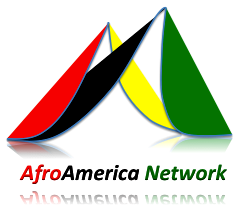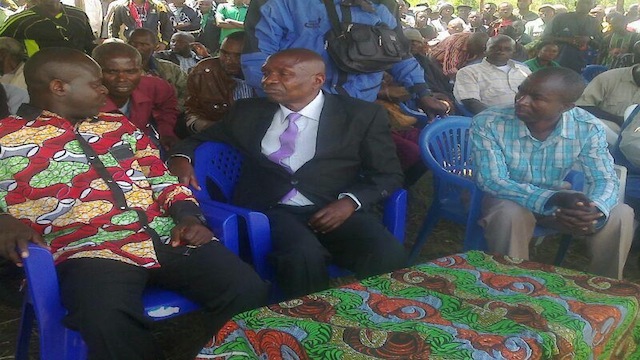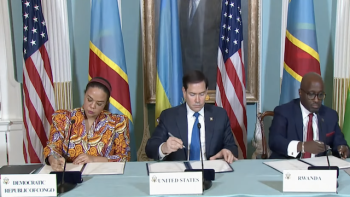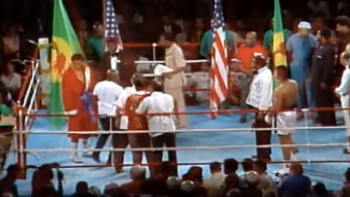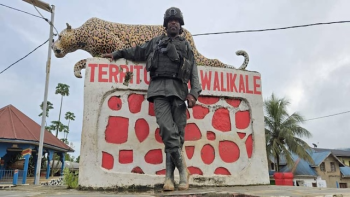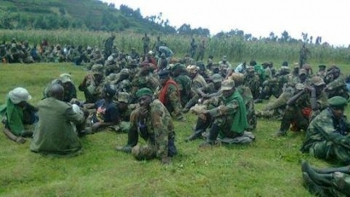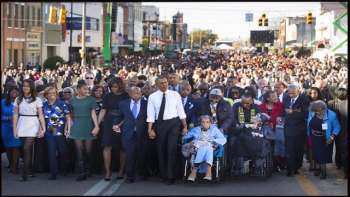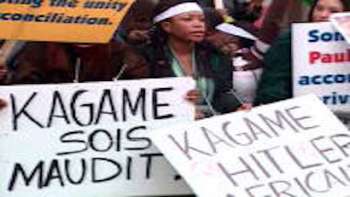As reported on May 20, 2014 by AfroAmerica Network, based on information provided by sources close to South African Development Community (SADC), one of the Rwandan rebels groups based in Eastern Democratic Republic of the Congo (DRC), known as Forces Democratic de Liberation du Rwanda -Forces Combattantes Abacunguzi (FDLR-FOCA), has disarmed some of its troops (see our previous article here).
The disarmament ceremony happened as scheduled on May 30, 2014, in the village of Kateku, Buleusa, in the Waikale territory. As predicted, around 102 troops along with their dependent were disarmed and regrouped in a camp. The camp was initially planned to be setup near Buleusa, in Kivu, Estern DRC and managed by SADC troops. Now, AfroAmerica has learned that those disarmed will be moved hundreds of miles away, to a camp in the town of Kanyabayonga.
The disarmament itself has raised more questions than answers. The major question is what would be the next steps.
A Ceremony Snubbed by the International Community, Regional Leaders, and DRC Government
The disarmament by FDLR-FOCA was advertised in advance by FDLR commanders, who had invited world leaders and the international community, especially the United Nations, the African Union, regional organizations and the DRC government to attend. None did or, at best, some sent lower level bureaucrats. The DRC Government sent the North-Kivu deputy provincial governor, Feller Lutaichirwa, the United Nations sent a staff within a department of the UN Mission in Congo (MONUSCO). The African Union Commissioner, Ms. Dlamini-Zuma Zuma, who was expected to attend, did not show up.
Those who attended expressed guarded optimism regarding the next steps.
According to some attendees, “this is the second such initiative in less than 6 months. The first one did not lead to very much and the second has striking resemblance to the first.” The first initiative, early this year, went unnoticed and was later dismissed by the United Nations Stabilization Mission in DRC, MONUSCO and both the DRC and General Kagame’s governments.
The major figure to attend the ceremony is a SADC troops commander Lt-Col Omar Majani. No one of the special envoys to the Great Lakes region, Mary Robinson and Russ Feingold, did attend. Mary Robinson sent a representative, Tom Young, after stating, in Kinshasa, that FDLR must be disarmed by force.
A Similar Initiative by RUD-Urunana and RPR-Inkeragutabara Failed Before.
As AfroAmerica Network reported on May 20, 2014, in 2008, two other DRC based Rwandan rebel groups launched a similar initiative in Kasiki, South Lubero. The initiative was launched after negotiations between National Democratic Congress (NDC), the coalition between the two groups, RUD-Urunana and RPR-Inkeragutabara, and DRC government. The negotiations, held in Rome in 2008, were mediated by the Roman Catholic organization, Sant’Egidio Community and supported by the Norwegian government.
A roadmap was subsequently signed in Kisangani in May 2008 and endorsed by the United Nations, the World Bank, Foreign Governments with Embassies in Kinshasa and other International Organizations such as the European Community.
The demobilization ceremony, held in Kasiki in July 2008 and led by the DRC Foreign Affairs Minister, Antipas Mbusa Nyamwisi, was attended by the representatives of international organizations and Embassies based in Kinshasa and representatives of the Rwandan Government.
A few months later, Rwandan General Paul Kagame and Congolese President Joseph Kabila secretly agreed to dismantle the camp. They gave orders to the Rwanda Defense Forces (RDF) and Congolese troops, FARDC, to attack the camps of disarmed RUD-Urunana and RPR-Inkeragutabara troops and their dependents. During the attacks, the RDF and FARDC killed several unarmed people, including children, women and elderly, and sent the remaining refugees into the bushes.
Confusion within the ranks
Sources within FDLR say there heightened confusion. Some combatants wondered whether the ceremony was a surrender and giving up the rebellion?
Another confusion comes from the inexistent financial support from the international community for the disarmament initiative. In a week leading to the disarmament ceremony, the combatants and their relatives had to build huts to house the disarmed combatants and their relatives, and to fend for themselves for food, water and other sanitations. After the disarmament, commanders of SADC troops within the UN Intervention Brigade informed FDLR-FOCA leaders that the disarmed troops will be moved to Kanyabayonga, more than a hundred miles from Buleusa.
Skepticism within the International Community
Immediately after the disarmament ceremony, UN Secretary General Representative in DRC and Head of MONUSCO, Martin Kobler, dismissed the significance of the FDLR initiative:
"It takes more than speeches of good intention to convince the World. A verbal commitment by FDLR leaders is not enough, we need action,” Martin Kobler told the media, before adding, in a unveiled threat and eachoing the recent statements on UN Special Envoy Mary Robinson: "There is only one valid process of disarmament. Each fighter must surrender himself and hand in his weapon to MONUSCO. Until that happens, pressure and military operations will continue. "
Bizarre reaction from the DRC Government
The DRC government was not really involved in the initiative and has, since the beginning, shown that the disarmament was not any of their concerns. After the ceremony, the self styled Congolese Information Minister, Lambert Mende Omalanga, told the media that with the disarmament of the 102 FDRL troops, the FDLR issue was resolved.
For General Paul Kagame’s government, FDLR disarmament appears a non-event.
Up to now, no official reaction from General Paul Kagame’s government. It appears the initiative was a non-event. Yet, during the ceremony, the Rwandan refugees under the protection of FDLR and FDLR combatants relatives were hopeful about returning home to Rwanda.
"A day will come when we return home. And that day is approaching," sang the Rwandan FDLR rebels and their dependents during the ceremony on Friday May 30, 2014, in front of the primary school of Kateku, in Buleusa.
The FDLR President, Major General Gaston Iyamuremye, told the audience during his speech: “Our gesture today reflects our desire to see all people and all states in the region living in peace and harmony.” He then added that General Paul Kagame must engage in negotiations and open an Inter-Rwandan dialogue.
Observers wondered how, General Paul Kagame, who has ignored the gesture, will be brought to the negotiating table.
A Repeat of Kasiki, 6 years later, minus the support from DRC Government and the International Community?
When the Kasiki initiative was launched in 2008 and 2009, FDLR leaders were quick to denounce the leaders of the other two armed groups, RUD-Urunana and RPR-Inkegarugataba, of being traitors and serving the interests of General Paul Kagame, by disarming a part of their troops. Six years later, FDLR leaders appear to have opted for a process similar to what they vehemently denounced, albeit with no support from the DRC government and the International Community.
The Disarmament has Led to More Questions
What has changed? What will the initiative accomplish? What will happen to the disarmed troops once in Kanyaboyonga, far from FDLR positions? Is Martin Kobler going to implement a forced disarmament as he threatened? For how long SADC troops will protect the disarmed combatants and their relatives before sending them to Rwanda? What will happen if General Paul Kagame does not negotiate? What is next for FDLR-FOCA?
More questions than answers.
©2014 AfroAmerica Network. All Rights Reserved.
Rwandan Rebels, FDLR-FOCA, Disarm Some of Their Troops. What’s Next?
Typography
- Smaller Small Medium Big Bigger
- Default Helvetica Segoe Georgia Times
- Reading Mode


